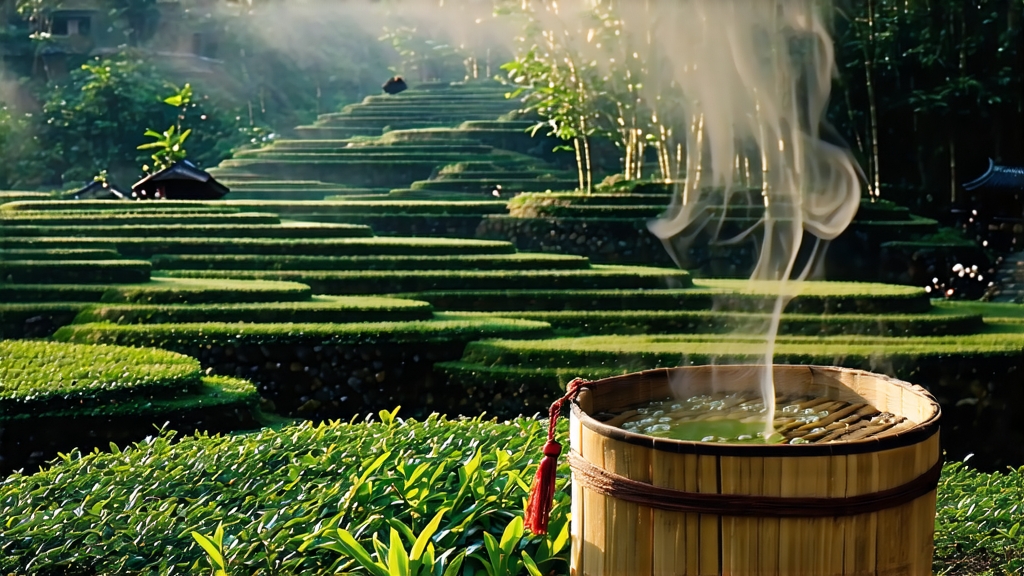
High among the perennially mist-capped Meng Ding Mountains of Ya’an, Sichuan, a tea once reserved for emperors still unfurls its down-covered buds each early April. Called Meng Ding Huang Ya—“Mengding Yellow Bud”—it is the least-known yet most aristocratic member of China’s tiny yellow-tea family. While green tea dominates export menus and dark pu-erh fills investment vaults, yellow tea remains a whispered secret among growers, a category so scarce that even in China only a few thousand kilograms reach market every spring. Meng Ding Huang Ya is the style that gave yellow tea its name, its history, and its unique “smother-fermentation” craft. For international drinkers who seek nuance beyond green tea’s grassy bite or white tea’s airy sweetness, Meng Ding Huang Ya offers a mellow, chestnut-cream cup that seems to suspend time itself.
Historical scrolls kept in the mountain’s Ganlu Temple record that monk Wu Lizhen planted seven tea bushes on Meng Ding’s summit in 53 BCE, presenting the harvest to Emperor Han Xuan. By the Tang dynasty (618-907 CE) the tea had become an imperial tribute, carried 1,400 km by fast horse to Chang’an within seven days so that the Son of Heaven could “taste the spring before the people.” The Song Annals of Sichuan (978 CE) first used the phrase “yellow bud” to describe the pale golden color the leaf took on when lightly fermented, distinguishing it from the greener teas of neighboring regions. When the Ming court moved the capital north, tribute routes shifted, and Meng Ding Huang Ya vanished from palace records, surviving only in monastery gardens. It was not until 1959 that provincial agronomists rediscovered the heirloom cultivar ‘Ming Shan Xiao Ye Zhong’ (Mt. Ming Small-Leaf Lineage) and re-established commercial production under the watchful eye of the China Tea Research Institute. Today the entire harvest comes from fewer than 300 acres scattered between 800 m and 1,400 m on the northern flank of the mountain, shrouded by 280 foggy days a year and irrigated by the same springs that once fed the ancient Dujiangyan irrigation system.
Although yellow tea is often lumped into a single category, connoisseurs recognize three substyles defined by leaf grade and degree of smother-fermentation: bud-only Huang Ya (Ya’an, Meng Ding), one-bud-one-leaf Huang Xiao Cha (Hunan’s Jun Shan Yin Zhen), and larger-leaf Huang Da Cha (Anhui’s Huo Shan Huang Da Cha). Meng Ding Huang Ya is the purest expression of the first style: only the unopened bud, or at most the bud with a half-unfurled first leaf, is plucked during the five-day “ming qian” window before the Qingming festival. The goal is to capture the amino-acid richness that peaks when night temperatures still dip below 10 °C, halting photosynthesis and locking in the sweet, umami-laden theanine that later crafts the tea’s signature broth.
The craft behind Meng Ding Huang Ya is a masterclass in controlled oxidation. After picking, the buds are spread on bamboo trays and withered for four to six hours in shaded corridors where mountain breezes reduce moisture to roughly 65 %. A quick 80 °C “sha qing” (kill-green) roast in iron woks lasting only 90 seconds per 250 g batch denatures the leaf enzymes, but—crucially—does not drive off all water. While green tea would now be rolled and dried, yellow tea enters its namesake “men huang” (smother-fermentation) phase. The still-warm buds are wrapped in thick linen or stacked inside small wooden boxes lined with wet parchment; the core temperature hovers at 35 °C for four to six hours. During this humid nap the leaf re-absorbs its own respired moisture, re-activating gentle enzymatic oxidation that turns chlorophyll into pheophytin and converts catechins into theaflavins, yielding the pale straw-yellow infusion and mellowing any residual grassiness. The cycle is repeated three times—wrap, unwrap, air, re-wrap—each cycle shortening as the leaf ferments more quickly. Finally the buds are given a low-temperature charcoal bake at 50 °C for two hours, then rested for seven days so that the last 4 % of moisture migrates